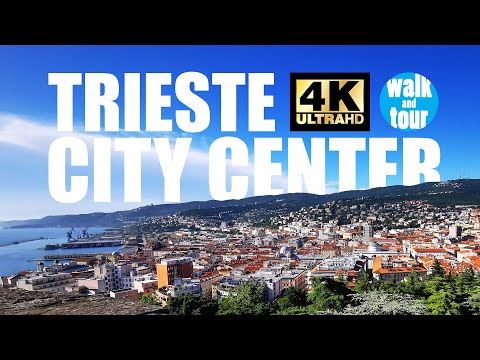Trieste - Evening walk - City Center 4K UHD

Trieste is a city and a seaport in northeastern Italy. It is towards the end of a narrow strip of Italian territory lying between the Adriatic Sea and Slovenia. Croatia is some 30 km (19 mi) to the south. Piazza Unità d'Italia is the main square in Trieste. Located at the foot of the hill with the castle of San Giusto, the square faces the Adriatic Sea. It is often said to be Europe's largest square located next to the sea.
The square was built during the period when Trieste was the most important seaport of the Austrian-Hungarian Empire. It includes the city's municipal buildings and other important palaces. Before 1919 it was known as Piazza Grande, or Great Square.
The square itself has occasionally been used as a concert venue. Green Day (2013) or Iron Maiden (2016) performed here live. Designed by architect Giuseppe Bruni, Trieste's City Hall was built between 1873 and 1875. Fontana dei Quattro Continenti is a baroque fountain, named for the four continents known when it went up (Europe, Asia, Africa, America). The eclectic style facade gives the building a monumental grandeur, forming a beautiful scenic backdrop of a stage, open to the sea. Now, we are on a way to Piazza della Borsa (Stock Exchange Square).
It is one of the main squares of Trieste. Also known as the second good city lounge the square was the economic center of the city throughout the nineteenth century. The place where the square stands was once located just outside the city walls. In the square there are numerous other buildings, today mostly used as bank offices or shops. This is an Italian organizations that promote business activities. Companies are required to register in the chamber of the province they belong to ...
... as well as filing their annual financial accounts to Registro delle Imprese. Trieste was one of the oldest parts of the Habsburg Monarchy, belonging to it from 1382 until 1918. In the 19th century the monarchy was one of the Great Powers of Europe and Trieste was its most important seaport. Trieste became the fourth largest city of the Austro-Hungarian Empire (after Vienna, Budapest, and Prague). At the end of the 19th century it emerged as an important hub for literature and music. Trieste is a maritime gateway for Northern Italy, Germany, Austria and Central Europe ...
... and is considered the end point of the Maritime Silk Road with its connections via the Suez Canal and Turkey ... ... and the other Overland to Africa, China, Japan and many countries in Asia. In the heart of Borgo Teresiano, the old district by the sea, Ponterosso Market takes place every day in the open air. Around 50 stalls are set up that offer accessories and clothes, fruit, vegetables and other kinds of goods. The fruit and veg is always good and sold at competitive prices. This market is a favorite with people from nearby Slovenia and Croatia, who pack this area. The Canal Grande is a navigable canal that is located in the heart of the Borgo Teresiano The Orthodox community in Trieste was established in 1748. Saint Spyridon Church treasury holds numerous objects, icons and various works of art, dating back to 1751.
This is the main religious building in the Borgo Teresiano in the centre of Trieste as well as the city's largest Catholic church. The building project dates back to 1808, but work only began in 1825. Trieste is a very important italian port. The oil terminal feeds the Transalpine Pipeline which covers 40% of Germany's energy requirements ... ..., 90% of Austria and 50% of the Czech Republic's. The thriving coffee industry in Trieste began under Austria-Hungary...
The Austro-Hungarian government even awarded tax-free status to the city in order to encourage more commerce. As a result, present-day Trieste boasts many cafes, and is still known to this day as "the coffee capital of Italy". About 200 000 people are residing in Trieste, located in the province of Trieste.
2021-07-26 07:43


